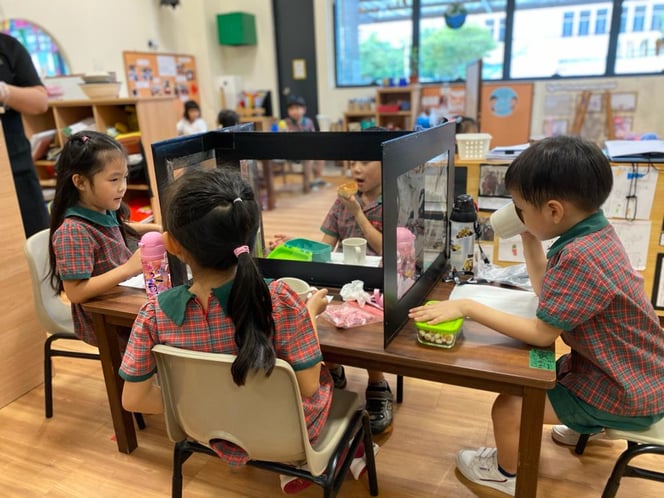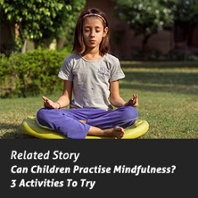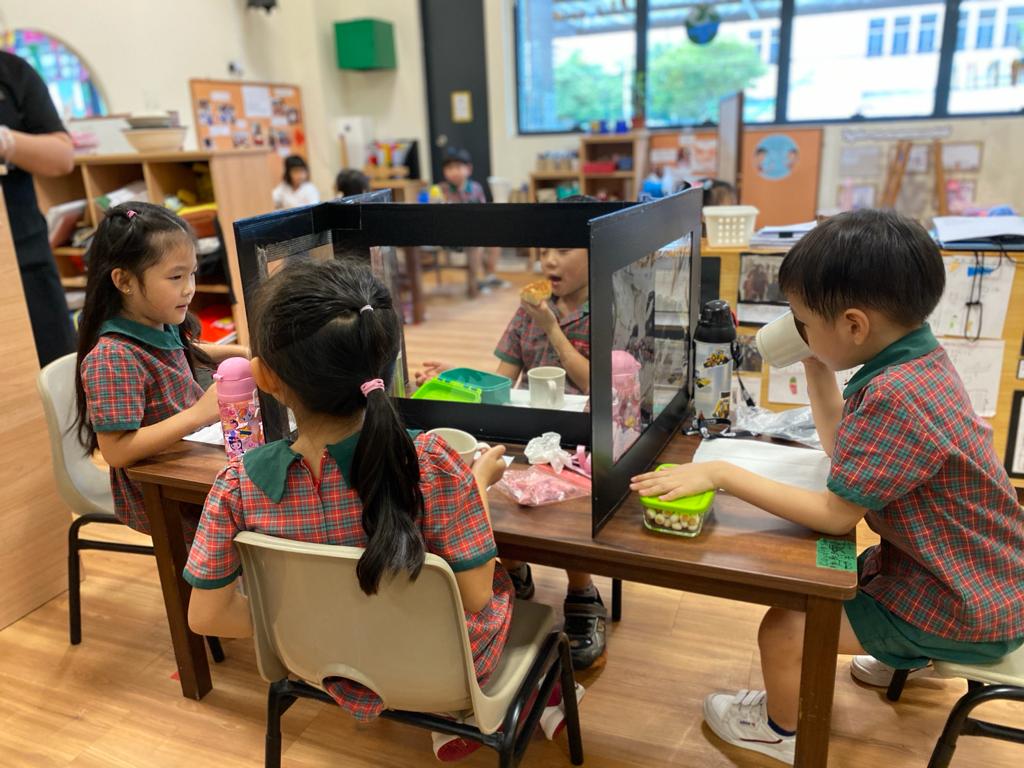-1.png)
EtonHouse Singapore

Now that the circuit breaker has ended and our schools have opened up, our children face a new normal with masks and safe distancing rules in place. We understand that this may pose a challenge, especially for young children. As parents, you want to prepare them for this as well as educate them on the safety measures they should follow. We find out from our colleagues on how to prepare your children for school after the circuit breaker.
You can listen to the podcast here.
How have our schools been preparing for the reopening after the circuit breaker?
Here are some of the things we do at EtonHouse apart from those mandated by the government. Our main focus is to prepare our environment and implement safety measures that keep our children safe yet comfortable.
- Customising various safe distancing stickers, posters and standees with characters from our books to remind children about safe distancing and wearing masks.
- Designed a safety measures booklet called ‘Physically apart, together at heart’. A phrase coined for EtonHouse during this period. The booklet is for parents to guide them through how the school will look like after it reopens and includes some parenting tips as well as reflection sheets that the children can do to prepare for the reopening of school. It contains clear explanations with illustrations.
- Environment infection risk assessment- principals do a thorough sweep of the school grounds to highlight points of possible infection and how they can mitigate the risks.
- All schools to keep a detailed illnesses log of every child or staff member who are ill who were sent home. This includes finding out why someone is not present in school, the reasons why. We track the health status of every individual until they are back at school.
- Analyse data recorded by our schools and try to establish the possible links. This process is extremely important because it gives us quick information when we need it and an overall picture of the health status of our school community.
What are some resources that parents can access to prepare for life after the circuit breaker?
We have a dedicated team who has come up with a Learning Channel where we curate and collate content that our teachers have been producing for home-based learning. We have also collaborated with a number of local authors where they read their storybooks to our children. It is an exclusive platform for our EtonHouse families. On top of that, we have a parenting site where we feature parenting tips and different activities we can do at home.
How can parents support the emotional well-being of children as they prepare them for school after nearly 2 months of staying at home?
It is important for us to be aware of our emotions before we can support the emotional well-being of our children. Children do face difficulty with every transition. There will be some overwhelming emotions and worries that they cannot process. Parents can support their child with these few simple steps:
- Set up a back to school routine. Creating a structure helps children to anticipate what is expected ahead of them. Involve them in building an essential agreement on the back to school routine. You can start by inviting them to think about what needs to be done, what help do they need and what can they do on their own.
- Have conversations with your child about going back to school. Children will experience anxiety and
 stress about going back to school after a long break. You can offer support by encouraging them to share how they feel and validate their feelings. Very often as adults, we try to fix or talk children out of their feelings. We need to be mindful that children need time to process the what and why of what they are feeling.
stress about going back to school after a long break. You can offer support by encouraging them to share how they feel and validate their feelings. Very often as adults, we try to fix or talk children out of their feelings. We need to be mindful that children need time to process the what and why of what they are feeling. - Focus on the positive. Try reminding your child about the things he or she like about school. This could be anything ranging from a play area, activities in school, school’s lunch menu a specific teacher or friend. Invite your child to draw and write down his or her thoughts.
What are some strategies that parents can adopt over the next few weeks as the children start to experience new school routines and safe distancing measures in place?
With the safe distancing measures in place, school routines will look different and children will not be able to play with their friends like they used to. During these times of change and transition, children may express or display certain behaviour out of the norm due to the stress and anxiety that they are feeling. They may be extra clingy, refuse their normal routine, show signs of a loss of appetite, display a frequency of nightmares and maybe even sleep regressions. It is important to look out for these signs and address our child’s worries. One of the very helpful tools is using powerful phrases in having a conversations with your children when it comes to understanding their worries:
- ‘How can I help?’- It is used to offer our abilities without taking away our children’s responsibilities in problem-solving. For example, when you're trying to talk to your child about their worry or anxiety, try saying ‘how can I help to make you feel better?’
- ‘Tell me about it’- this phrase helps you to ask for your child’s input rather than jumping into the assumptions of how he or she feeling.
- ‘At the same time’- this phrase helps to connect before we correct. By using the word ‘but’, it can do a lot of unintentional damage to the emotional connection we are trying to have with our children so try to replace the word ‘but’ with ‘at the same time’. For example, ‘I know you're sad that you cannot hug your friend. At the same time, you need to keep a safe distance from others when you're outside of the house. This helps to empower our children to understand why he or she is not able to do the things that they were used to and think of other creative ways.
- 'What do you think you could do?’ This phrase gives our child the autonomy to practice his or her problem-solving process. As parents, we may be experienced problem solvers and we tend to fall into the habit of wanting to go right in and fix every problem our child faces. Using the phrase ‘what do you think you can do to show your friend that you can without hugging him or her?’ allows your child to think of ways that she could approach the same situation in a different way.
Helping children to focus on what they can do helps in such stressful times. All these conversations with simple language and concepts are relatable to your child Remember, children may need repetition and one conversation may not be sufficient.
As a parent to a teenager, how can we prepare our child for school after circuit breaker?
For older children, the context is slightly different. They are cognisant of the fact that safe distancing is important. They understand the changes that are happening around themselves and in their lives during the circuit breaker and now going back to school. They are better equipped in their ways of dealing with these changes. Having said that, it is still a big change for them having spent the last 2 months doing home-based learning(HBL).
- A significant change would be the addition of travel time to their routine and in our case, nearly 2 hours of travel time will be added to my son's day. The reintroduction of school routines will also impact their lives. There will be a lot less time to rest and recharge.
- The second aspect of change will be the planning of resources. At the moment it is as simple as reaching out for a book in their bookshelves in order to access a lesson that is happening during home-based learning. However, once schools start, you have to plan in advance, pack your bags the night before, and ensure that all of your learning resources are in place.
- The third change would be the content of learning. At the moment assessments, for example, are taking place based on classroom content but once they go back to school there will be time-bound assessments on the entire syllabus AKA exams. The skills and competence that will be required for them to access these assessments will be different from HBL.
How can we prepare them physically, emotionally, and cognitively?
- Work out a plan, a sort of a countdown leading up to the opening. This includes changing routines to align with when school reopens, sleeping early progressively since bedtime was different during HBL.
- Organising and sorting all school resources so that are easily available during the week.
- Prepare a separate kit for health and safety resources with thermometers, masks, zip lock bags, hand sanitisers, etc.
- Regularly talking about what school will look like after the circuit breaker. They may be older but you still have to communicate with them about these changes. The fact that you cannot hug your friend, or sit close to them or play a game of basketball, etc. Every now and then when I have these conversations with my teenager, I do see him rolling his eyes a little bit and that's ok. But it is important to address these changes and reinforce them to help them adjust to the new normal.
- Finally don’t forget yourself. As parents during the last 2 months, we’ve been with our children, keeping them safe, ensuring that they are having their vitamins and meals on time, not meeting others, maintaining safe distancing measures when they step out, etc. Now that they will be back in school and we will not be entirely in control of their safety measures, this can cause some anxiety. It is important to tell yourself that it is ok. The school and authorities are equipped to ensure that all safety measures are in place. This is a positive development. Going back to school indicates that we are on the mend.


